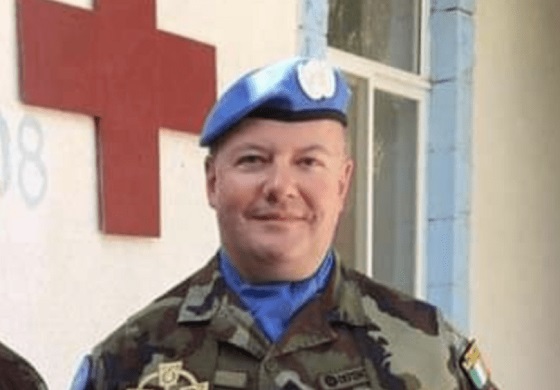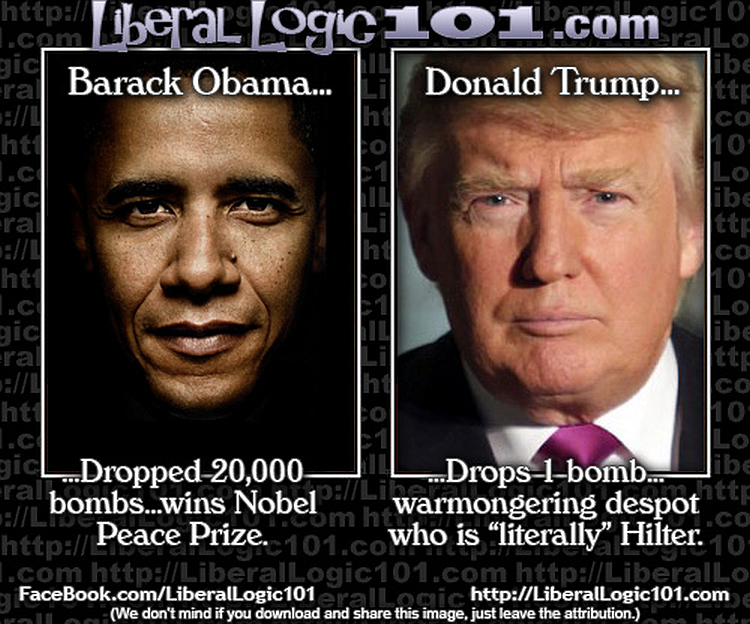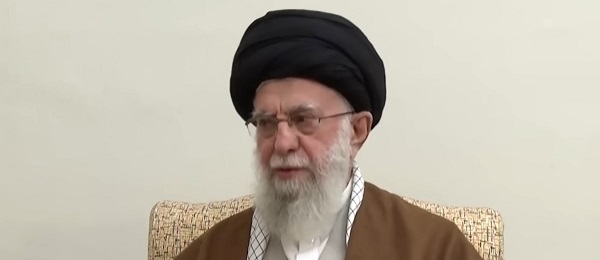conflict
Catholic priest ambushed, stabbed multiple times in ‘frenzied’ attack

Fr. Paul Murphy, Irish Army Chaplain (credit: Catholic Arena / X)
From LifeSiteNews
By Frank Wright
There are now concerns that the teenager became radicalized online and that he had a specific grievance and plan to target Defence Forces members.
A Catholic priest, who serves as a chaplain in the Irish Army, was ambushed and stabbed “multiple times” in a “frenzied attack” on Thursday night in Galway, Ireland – which saw Irish soldiers open fire in response. Initial reports said a “teenage male youth” had been detained, who reportedly “uttered statements about Irish military involvement in the Middle East.”
Virgin Media News issued the following report on the violent assault today:
WATCH: Man Injured in Stabbing at Renmore Army Barracks, Teen Arrested
For more, watch VM News now at https://t.co/JdZsXkTyaO#Galway #Renmore #stabbing pic.twitter.com/uJbr0zJ9M4— Virgin Media News (@VirginMediaNews) August 16, 2024
Father Paul Murphy, a 52 year old Chaplain with the Irish Army, was stabbed outside Renmore Barracks, Galway in the West of Ireland at around 10:45 p.m. last night as he arrived for duty in his car.
 Fr. Paul Murphy, Irish Army Chaplain (credit: Catholic Arena / X)
Fr. Paul Murphy, Irish Army Chaplain (credit: Catholic Arena / X)
Fr. Murphy was seriously injured, but survived the attack – sending a message from Galway’s University Hospital as he awaits surgery.
He thanked people in a Facebook post on Friday for their “prayers, love and concern.”
I’m doing okay: just awaiting surgery. All will be well.
According to the Irish Mirror, police are investigating whether the incident was terror related.
The Special Detective Unit of An Garda Síochána [Irish police] is involved in this investigation. One line of enquiry is to establish if this attack had a terrorism motivation.
Irish Mirror journalist Paul Healy reported details of the attack:
It is understood Fr. Murphy was sitting in his car waiting for the barracks gates to open when the attacker approached him.
Sources say the chaplain lowered his window and the attacker immediately stabbed him multiple times.
Healy goes on to recount how Fr. Murphy tried to escape, stating:
The gates of the barracks then opened and Fr. Murphy is understood to have driven forward in an effort to get away from the stabber.
The attacker however clung onto the vehicle and continued to try and attack Fr. Murphy.
Irish soldiers then “fired a number of warning shots,” Healy said, adding that a search of the suspect’s home saw evidence which may explain the motive.
Sources say Gardaí [police] have since searched the suspect’s address in the Galway area and a number of items of interest, including radicalized ‘literature’ were recovered.
There are now concerns that the teenager became radicalized online and that he had a specific grievance and plan to target Defence Forces members.
Healy further reports that “online social media posts” made by the suspect are now being reviewed.
The suspect, described as “Irish” and said to be 16-years-old, “remains in detention and is being questioned in a Gardaí station in the North Western region,” according to the Irish Examiner.
Their report says how “sentries overpowered the youth and detained him” until police arrived, noting that, “Fr. Murphy was provided with first aid at the scene before being taken to hospital where he received further treatment.”
A soldier who had served with Fr. Murphy on a tour of duty in Lebanon responded with shock and words of admiration for the Padre.
Brendan Cruise said on X:
I was fortunate enough to have served in Lebanon with Fr Paul Murphy who was the battalion padre. He was absolutely brilliant on the tour, he had time for everyone & a smile for all. Wishing him a full recovery.
Simon Harris, the Taoiseach [Irish Prime Minister] said his “thoughts are with the victim” and thanked the Defence Forces and Gardaí for their action and response in a post on X.
I have been briefed on the shocking incident outside Renmore Barracks last night & my thoughts are with the member of the defence forces in hospital. I want to thank defence forces personnel & Gardai for their action and response.
— Simon Harris TD (@SimonHarrisTD) August 16, 2024
Irish users of the social media platform responded angrily, with many holding Harris and the government responsible.
One user replied to Harris saying, “You’ve brought terror back to this Island, after we fought 800 years to live in peace.”
Others noted the Godlessness of the modern Irish state, remarking the deliberate omission of the fact that the victim is a Catholic priest and that no prayers were being offered by the leader of the Catholic nation.
“Very telling you won’t say a Catholic priest was attacked and you offer no prayers for him.”
The sentiment in the replies to the Irish Prime Minister were perhaps summarized best in this meme:

Attacks on Catholics and their places of worship have been on the rise in Ireland. A spate of anti-Catholic crime in County Donegal over the summer saw many churches burgled, with damage and attempted arson occuring. One church in Lifford had been targeted three times in six weeks.
The Protestant Church of Ireland has also been targeted, with historic and “irreplaceable” mummies damaged following a break-in and attempted arson in St Michan’s Church, Dublin in June.
The vandalism, according to Dublin Live, is believed to have ruined the mummified remains of five Catholics “including an 800-year-old artifact known as ‘The Crusader.’” A Romanian national was found guilty of the damage.
Yet the attacks have also been linked to hate speech – not online – but made by Irish politicians themselves.
In April, reporting on arson attacks on two County Meath churches, Catholic Arena alleged:
Hate speech by politicians against Catholics has been a major factor in the recent rise in crime against Catholic.
The attempts to burn down these two churches came shortly after an Irish Member of Parliament (TD) was “mocked for her Catholic faith” by her fellow members during a speech given in the Parliament itself, known as the Dáil.
Gript reported on March 23 how Deputy Carol Nolan’s warning that mass migration policies of the Irish government had created chaos in the country.
“We have an immigration system and an immigrant homeless situation that are nothing short of spiralling social sabotage,” Nolan said.
“This Government has no answers for one simple reason, it is because it does not ask the right questions and it does not listen.”
Nolan was reportedly “sniggered at” at by members she referred to as “communists,” who she says derided her and other members for their Christian faith – whilst refusing to acknowledge the chaos their open borders policies were causing.
“I could hear the comments and the muttering – some TDs were definitely mocking our Catholic faith”
Nolan claimed the anti-Catholic rhetoric emerged over Ireland’s referendum on abortion, when she says was targeted for being pro-life. She explained:
Unfortunately, I had this trouble before the abortion referendum, and when I called for a ‘No’ vote [to legalising abortion]…so it’s not the first time I have borne the brunt of that type of sentiment.
Nolan said:
I would get a lot of it, and I got a lot of it because it was evident I was pro-life and because of my beliefs.
She remained defiant in the face of this “bullying,” saying Parliament refused to reflect a majority of Irish people whose lives and livelihoods in tourism have been blighted by uncontrolled mass migration.
“In advance of Holy Week, we will take no lectures from the hard left and the looney left who will not face the people.”
The comments in the Irish Parliament came weeks after a priest’s house was set ablaze “intentionally” in Kildare, destroying outbuildings at St Brigid’s Cathedral.
Somebody set fire to a priests house in Ireland 2 days ago.
Why wasn't the priest invited onto TV to discuss like the Muslim cleric was? pic.twitter.com/p4XP3QITyq
— MichaeloKeeffe (@Mick_O_Keeffe) February 21, 2024
The attacks on the Catholic faith and on Christianity in Ireland have now seemingly escalated to the attempted murder of a priest.
conflict
Obama Dropped Over 26K Bombs Without Congressional Approval

@miss_stacey_ Biden, Clinton, Obama & Harris on Iran #biden #clinton #obama #harris #trump #iran #nuclear
Iran has been the target for decades. Biden, Harris, and Clinton—all the Democrats have said that they would attack Iran if given the opportunity. It appears that Donald Trump is attempting to mitigate a potentially irresolvable situation. As he bluntly told reporters: We basically — we have two countries that have been fighting so long and so hard that they don’t know what the f‑‑‑ they’re doing.”
A portion of the nation believes Trump acted like a dictator by attacking Iran without Congressional approval. I explained how former President Barack Obama decimated the War Powers Resolution Act when he decided Libya was overdue for a regime change. The War Powers Act, or War Powers Resolution of 1973, grants the POTUS the ability to send American troops into battle if Congress receives a 48-hour notice. The stipulation here is that troops cannot remain in battle for over 60 days unless Congress authorizes a declaration of war. Congress could also remove US forces at any time by passing a resolution.
Libya is one of seven nations that Obama bombed without Congressional approval, yet no one remembers him as a wartime president, as the United States was not technically at war. Over 26,000 bombs were deployed across 7 nations under his command in 2016 alone. Libya, Afghanistan, Syria, Yemen, Somalia, Iraq, and Pakistan were attacked without a single vote. Donald Trump’s recent orders saw 36 bombs deployed in Iran.
The majority of those bombings happened in Syria, Libya, and Iraq under the premise of targeting extremist groups like ISIS. Drone strikes were carried out across Somalia, Yemen, and Pakistan as the Obama Administration accused those nations of hosting al-Qaeda affiliated groups. Coincidentally, USAID was also providing funding to those groups.
The 2001 Authorization for Use of Military Force (AUMF) was initially implemented to hunt down the Taliban and al-Qaeda after the 9/11 terrorist attacks. Obama broadened his interpretation of the AUMF and incorporated newly formed militant groups that were allegedly expanding across the entire Middle East. The Bureau of Investigative Journalism believes there were up to 1,100 civilian casualties in Pakistan, Yemen, and Somalia. Thousands of civilians died in Syria and Iraq but the death toll was never calculated. At least 100 innocent people died in the 2016 attacks in Afghanistan alone.
The government will always augment the law for their personal agenda. The War Powers Resolution was ignored and the AUMF was altered. Congress was, however, successful in preventing Obama from putting US troops on the ground and fighting a full-scale war. In 2013, Obama sought congressional approval for military action in Syria but was denied. Obama again attempted to deploy troops in 2015 but was denied. Congress has to redraft the AUMF to specifically prevent Obama from deploying troops in the Middle East. “The authorization… does not authorize the use of the United States Armed Forces on the ground in Syria for the purpose of combat operations.” Obama attempted to redraft the AUMF on his own by insisting he would prohibit “enduring offensive ground combat operations” or long-term deployment of troops. He was met with bipartisan disapproval as both sides believed he was attempting to drag the United States into another unnecessary war.
The United States should not be involved in any of these battles, but here we are. Those living in fear that Donald Trump is a dictator fail to recognize that past leadership had every intention of sending American men and women into battle unilaterally without a single vote cast.
conflict
The Oil Price Spike That Didn’t Happen


From the Daily Caller News Foundation
By David Blackmon
What if they gave an oil price spike and nobody came? That is admittedly kind of a lame play on an old saying about parties, but it’s exactly what has happened over the two weeks since June 12, when Israel launched its initial assault on Iran.
At that day’s close of trading, the domestic U.S. WTI price sat at $68.04 per barrel. As of this writing on June 24, the price stands at $64.50. That’s not just the absence of a price spike, it is the opposite of one, a drop of 5% in just two weeks.
So, what happened? Why didn’t crude prices spike significantly? For such a seemingly complex trading market that is impacted daily by a broad variety of factors, the answer here is surprisingly simple, boiling down to just two key factors.
Dear Readers:
As a nonprofit, we are dependent on the generosity of our readers.
Please consider making a small donation of any amount here.
Thank you!
- Neither Israel nor the United States made an effort to target Iran’s refining or export infrastructures.
- Despite some tepid, sporadic saber rattling by Iranian officials, they mounted no real effort to block the flow of crude tankers through the region’s critical choke point, the Strait of Hormuz.
Hitting Iran’s infrastructure could have taken its substantial crude exports – which the International Energy Agency estimates to be 1.7 million barrels per day – off the global market, a big hit. Shutting down the Strait of Hormuz, through which about 20% of global crude supplies flow every day, would have been a much bigger hit, one that would have set prices on an upward spiral.
But the oil kept flowing, muting the few comparatively small increases in prices which did come about.
Respected analyst David Ramsden-Wood, writing at his “HotTakeOfTheDay” Substack newsletter, summed it up quite well. “Oil is still structurally bearish. U.S. producers are in PR mode—talking up ‘Drill, baby, drill’ while actually slowing down. Capex is flat to declining. Rig counts are down. Shareholders want returns, not growth. So we’re left with this: Tension in the Middle East, no supply impact, and U.S. production that’s quietly rolling over. Oil shrugged.”
There was a time, as recently as 10 years ago, when crude prices would have no doubt rocketed skywards at the news of both the commencement of Israel’s initial June 12 assault on Iran’s military and political targets and of last Saturday’s U.S. bombing operation. In those days, we could have expected crude prices to go as high as $100 per barrel or even higher. Markets used to really react to the “tension in the Middle East” to which Ramsden-Wood refers, in large part, because they had no real way to parse through all the uncertainties such events might create.
Now it’s different. Things have changed. The rise of machine learning, AI and other technological and communications advancements has played a major role.
In the past, a lack of real-time information during any rise in Middle East tensions left traders in the dark for some period of time – often extended periods – about potential impacts on production in the world’s biggest oil producing region. But that is no longer the case. Traders can now gauge potential impacts almost immediately.
That was especially true throughout this most recent upset, due to President Donald Trump’s transparency about everything that was taking place. You were able to know exactly what the U.S. was planning to do or had done just by regularly pressing the “refresh” button at Trump’s Truth Social feed.
Tim Stewart, President of the D.C.-based U.S. Oil and Gas Association, has a term for this. “The Markets are becoming much better at building the ‘47 Variable’ into their short-term models,” he said in an email. “This is not a Republican Administration – it is a Disrupter Administration and disruption happens both ways, so the old playbooks just don’t apply anymore. Traders are taking into account a President who means what he says, and it is best to plan for it.”
Add to all that the reality that a high percentage of crude trading is now conducted via automated, AI-controlled programs, and few trades are any longer made in the dark.
Thus, the world saw a price spike which, despite being widely predicted by many smart people, didn’t happen, and the reasons why are pretty simple.
David Blackmon is an energy writer and consultant based in Texas. He spent 40 years in the oil and gas business, where he specialized in public policy and communications.
(Featured Image Media Credit: Screen Capture/PBS NewsHour)
-

 COVID-197 hours ago
COVID-197 hours agoOntario man launches new challenge against province’s latest attempt to ban free expression on roadside billboards
-

 Energy15 hours ago
Energy15 hours agoThis Canada Day, Celebrate Energy Renewal
-

 Business1 day ago
Business1 day agoWhile China Hacks Canada, B.C. Sends Them a Billion-Dollar Ship Building Contract
-

 Alberta1 day ago
Alberta1 day agoSo Alberta, what’s next?
-

 Alberta6 hours ago
Alberta6 hours agoAlberta Next Takes A Look At Alberta Provincial Police Force
-

 Bjorn Lomborg1 day ago
Bjorn Lomborg1 day agoThe Physics Behind The Spanish Blackout
-

 Alberta8 hours ago
Alberta8 hours agoCanadian Oil Sands Production Expected to Reach All-time Highs this Year Despite Lower Oil Prices
-

 Business10 hours ago
Business10 hours agoPotential For Abuse Embedded In Bill C-5







